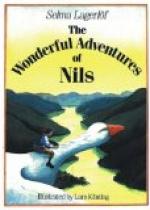Osa, the goose-girl, stood silent a long while, and pondered over the find. At last she said, slowly and thoughtfully: “Do you remember, little Mats, that when we went past Oevid Cloister, we heard that the folks in a farmyard had seen an elf who was dressed in leather breeches, and had wooden shoes on his feet, like any other working man? And do you recollect when we came to Vittskoevle, a girl told us that she had seen a Goa-Nisse with wooden shoes, who flew away on the back of a goose? And when we ourselves came home to our cabin, little Mats, we saw a goblin who was dressed in the same way, and who also straddled the back of a goose—and flew away. Maybe it was the same one who rode along on his goose up here in the air and dropped his wooden shoe.”
“Yes, it must have been,” said little Mats.
They turned the wooden shoe about and examined it carefully—for it isn’t every day that one happens across a Goa-Nisse’s wooden shoe on the highway.
“Wait, wait, little Mats!” said Osa, the goose-girl. “There is something written on one side of it.”
“Why, so there is! but they are such tiny letters.”
“Let me see! It says—it says: ‘Nils Holgersson from W. Vemminghoeg.’ That’s the most wonderful thing I’ve ever heard!” said little Mats.
THE STORY OF KARR AND GRAYSKIN
KARR
About twelve years before Nils Holgersson started on his travels with the wild geese there was a manufacturer at Kolmarden who wanted to be rid of one of his dogs. He sent for his game-keeper and said to him that it was impossible to keep the dog because he could not be broken of the habit of chasing all the sheep and fowl he set eyes on, and he asked the man to take the dog into the forest and shoot him.
The game-keeper slipped the leash on the dog to lead him to a spot in the forest where all the superannuated dogs from the manor were shot and buried. He was not a cruel man, but he was very glad to shoot that dog, for he knew that sheep and chickens were not the only creatures he hunted. Times without number he had gone into the forest and helped himself to a hare or a grouse-chick.
The dog was a little black-and-tan setter. His name was Karr, and he was so wise he understood all that was said.
As the game-keeper was leading him through the thickets, Karr knew only too well what was in store for him. But this no one could have guessed by his behaviour, for he neither hung his head nor dragged his tail, but seemed as unconcerned as ever.
It was because they were in the forest that the dog was so careful not to appear the least bit anxious.
There were great stretches of woodland on every side of the factory, and this forest was famed both among animals and human beings because for many, many years the owners had been so careful of it that they had begrudged themselves even the trees needed for firewood. Nor had they had the heart to thin or train them. The trees had been allowed to grow as they pleased. Naturally a forest thus protected was a beloved refuge for wild animals, which were to be found there in great numbers. Among themselves they called it Liberty Forest, and regarded it as the best retreat in the whole country.




